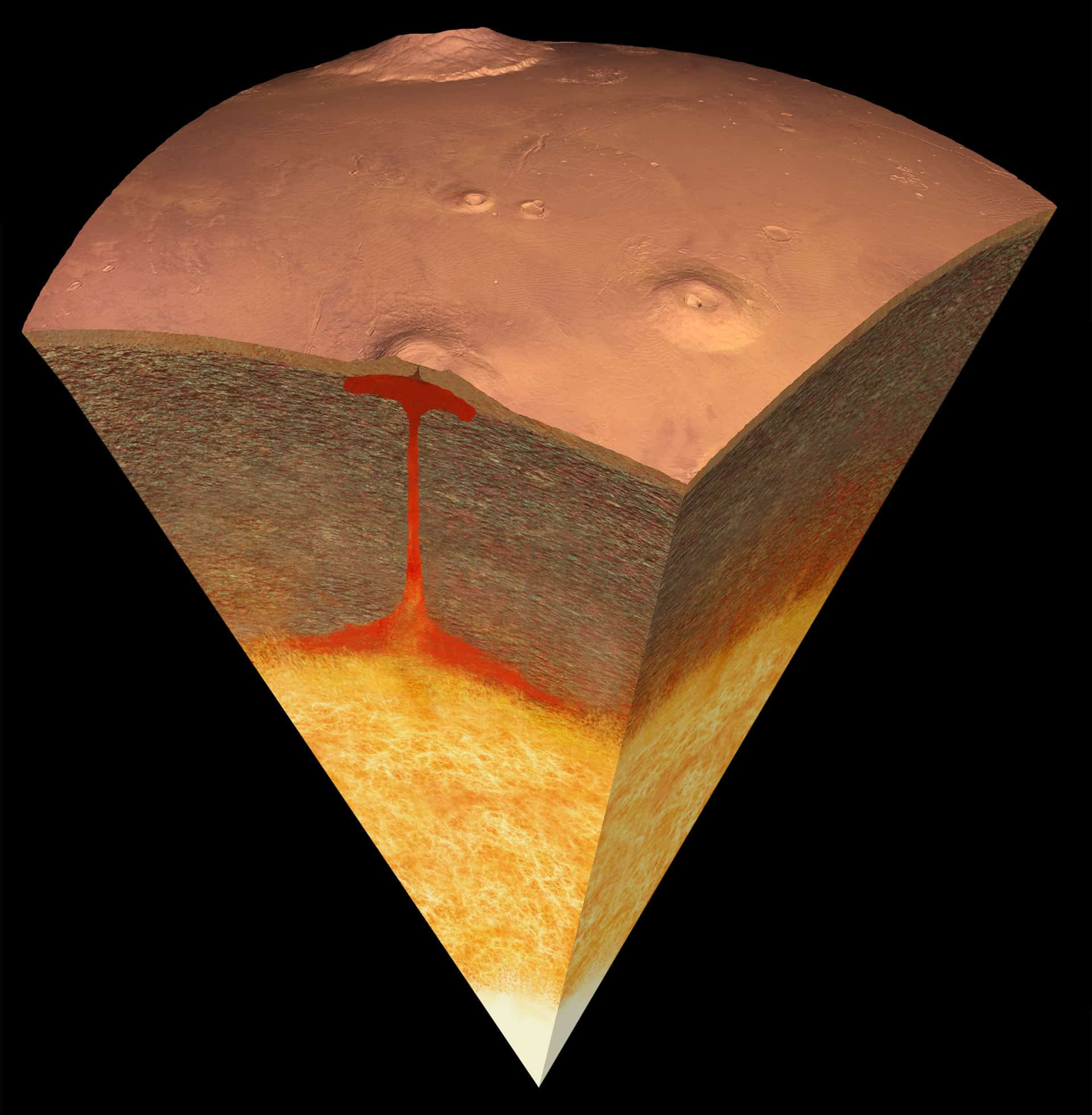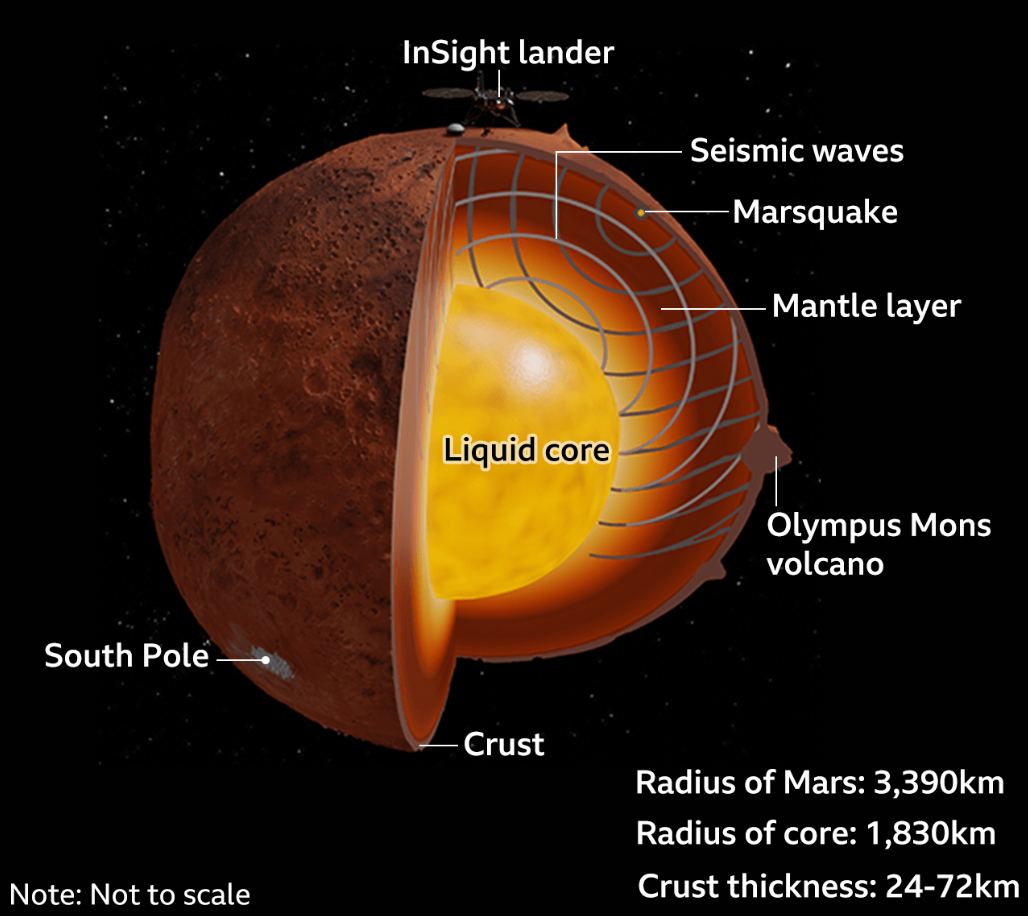In 2022, a seismometer installed on Mars recorded its largest marsquake yet. Thanks to the waves from this temblor, researchers were able to map the thickness of the Martian crust. Turns out, on average, it’s substantially thicker than the crust of our planet.

Mars doesn’t have plate tectonics. This could be a big part of why there’s no macroscopic life on Mars now and also plays a big role in the planet’s geologic activity — or the lack of it. The lack of active plate tectonics means Mars has far fewer quakes than our planet. For researchers looking to understand the Red Planet’s structure, that’s a problem.
The deepest hole we’ve dug on Earth is around 12 km deep. So we can’t even get close to the mantle, let alone the core. But we can assess the properties of the inside of our planet by analyzing earthquakes. Earthquakes send out acoustic waves (commonly called seismic waves). These waves propagate around the planet, and based on how they move through the subsurface, scientists can deduce some of the planet’s properties.

In this case, the marsquake had a magnitude of 4.6 — not powerful by Earth’s standards, but possibly as big as it gets on Mars.
“This marsquake sent out strong seismic waves that traveled along the surface of Mars,” says Doyeon Kim, a seismologist at the Institute of Geophysics at ETH Zurich, and one of the study authors.
Waves from the marsquake circled the planet several times, with surface waves circling the surface.
“From this quake, the largest quake recorded during the entire InSight mission, we observed surface waves that circled Mars up to three times,” says the seismologist and lead author of a study just published in the journal, Geophysical Research Letters.
In order to obtain information about the structure of the Martian crust, the researchers measured how fast these waves propagate at different frequencies. They then compared this information with gravitational data and other observations.
Thick skin
The researchers concluded that the crust averages 42 to 56 kilometers (26 – 35 miles) thick — that’s 70% thicker than on Earth. The continental crust on Earth is 21 to 27 kilometers (13 – 17 miles) thick. The lunar crust, for comparison, is between 34 and 43 kilometers (21 – 27 miles) thick.
“This means that the Martian crust is much thicker than that of the Earth or the Moon,” says Kim. Generally, smaller planetary bodies in our solar system have a thicker crust than the larger bodies. Kim explains, “We were fortunate to observe this quake. On Earth, we would have difficulty determining the thickness of the Earth’s crust using the same magnitude of quake that occurred on Mars. While Mars is smaller than the Earth, it transports seismic energy more efficiently.”

Overall, the crust varies from around 10 km (6 miles) at an impact basin to an impressive 90 km (56 miles). But Mars also has a strange duality. Its northern hemisphere is much flatter than the south. Furthermore, gravity data from Mars orbiters suggested that the planet’s northern hemisphere has a slightly lower gravitational pull. This typically means that the rocks are less dense.
But this new study suggests otherwise.
“Based on the seismic observations and the gravity data, we show that the density of the crust in the northern lowlands and the southern highlands is similar,” they write. In contrast, the crust in the southern hemisphere extends to a greater depth than in the northern hemisphere. “This finding is very exciting and allows an end to a long-standing scientific discussion on the origin and structure of the Martian crust,” says Kim.
Hot and cold Mars
Yet another conclusion can be drawn from the study. Specifically, in terms of heat.
If researchers know how thick the crust is, they can also estimate where the planet’s internal heat comes from. In the case of the Earth, internal heat comes from when the planet was formed, from the denser core material sinking to the center of the planet, and from the decay of radioactive elements. In the case of Mars, this radioactive decay seems to happen in the crust.
“Our study provides how the planet generates its heat and explains Mars’ thermal history,” says Kim. Areas with a lot of heat and radioactive elements could also be indicative of volcanic activity. This is still debated. Some researchers believed volcanic activity on Mars stopped long ago, but this new evidence suggests it may not be so straightforward.
Journal Reference: Kim D et.al: Global Crustal Thickness Revealed by Surface Waves Orbiting Mars. Geophysical Research Letters, 50, e2023GL103482. doi: external page10.22541/essoar.167810298.85030230/v1call_made


